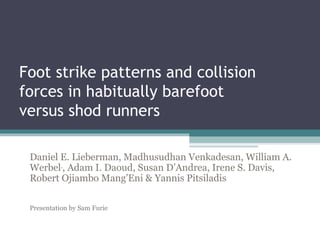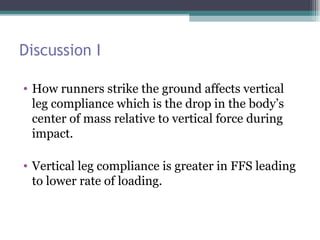Foot strike patterns and collision forces in barefoot vs shod runners by sam furie aug11
- 1. Foot strike patterns and collision forces in habitually barefoot versus shod runners Daniel E. Lieberman, Madhusudhan Venkadesan, William A. Werbel,, Adam I. Daoud, Susan DŌĆÖAndrea, Irene S. Davis, Robert Ojiambo MangŌĆÖEni & Yannis Pitsiladis Presentation by Sam Furie
- 2. Introduction ŌĆó Humans have engaged in endurance running for millions of years, but modern running shoes were not invented until the 1970ŌĆÖs. ŌĆó Researchers explored how runners struck the ground before the invention of modern running shoes. ŌĆó Before the invention of modern running shoes, most runners ran barefoot or in minimal footwear such as sandals. ┬Ā
- 3. Review of Literature ŌĆó The human heel pad cushions impact transients, but to a lesser extent (Chi and Schmidt, 2005; Ker et al., 1989; De Clercq et al., 1994). ŌĆó Habitually shod runners tend to adopt a flatter foot placement when barefoot than when shod, thus reducing stresses on the foot (Dewit et al., 2000; Divert et al., 2005; Eslami et al., 2007; Squadrone et al., 2009).
- 4. Hypothesis ŌĆó In this study, researchers investigated fore-foot and mid-foot strike patterns in relation to barefoot and shod running.
- 5. Methods I ŌĆó Five Groups Ō¢½ Habitually shod amateur and collegiate athletes from Harvard University Ō¢½ Adult athletes from Rift Valley Province of Kenya ’é¢ All habitually shod but 75% did not wear shoes until late teens Ō¢½ Self-identified habitual barefoot runners from the USA Ō¢½ Habitually barefoot group from rural primary school in Nandi District from Kenya Ō¢½ Habitually shod from urban primary school in Eldoret ’é¢ All children unshod since early childhood
- 6. Methods II ŌĆó Criteria: Ō¢½ Ran a minimum of 20 km per week Ō¢½ No history of injuries ŌĆó All subjects Ō¢½ Ran on flat track ways 20-25 m long Ō¢½ Recorded via a high-speed video camera placed 0.5 meters above ground
- 7. Methods III ŌĆó Groups 1,2,3 and 5 were recorded in barefoot AND in shoes. Ō¢½ Not group 4 because they have NEVER worn shoes Ō¢½ Groups 1 and 2 wore a neutral Asics shoe. Ō¢½ Groups 3 and 5 wore their own shoes. ŌĆó Impact force was recorded for runners in groups 1 and 3 (barefoot and shoes). ŌĆó Kenyan runners were not recorder on force plate.
- 8. Methods IV ŌĆó Subjects asked to run at preferred speed. ŌĆó Subjects recorded for 5-7 trials. Ō¢½ One minute rest to avoid fatigue
- 9. Results I ’éŚ Habitually shod runners who grew up wearing shoes rear-foot strike (groups 1 and 5). ’éŚ Runners who grew up barefoot or switched to barefoot fore-foot strike. ’éŚ Both groups sometimes land mid-foot strike in barefoot condition. ’éŚ Major factor in rear-foot strike in shod is cushioned heel orienting the sole as to have 5 degrees less dorsiflexion.
- 10. Results II
- 11. Results III
- 12. Results IV
- 13. Results V
- 14. Discussion I ŌĆó How runners strike the ground affects vertical leg compliance which is the drop in the bodyŌĆÖs center of mass relative to vertical force during impact. ŌĆó Vertical leg compliance is greater in FFS leading to lower rate of loading.
- 15. Discussion II ŌĆó Differences between RFS and FFS running make sense from an evolutionary perspective. Ō¢½ Most shod runners today land only on their heels. Ō¢½ Runners who run barefoot or wear minimalist shoes avoid RFS.
- 16. Conclusion ŌĆó RFS and FFS impact rates may lead to health implications. Ō¢½ Runners may be prone to repetitive stress injuries. Ō¢½ Less proprioception Ō¢½ Controlled studies are needed to test the hypothesis that individuals who do not RFS have reduced injury rates.
- 17. Acknowledgements ŌĆó Mrs.Fauber ŌĆó Dr.Scoville ŌĆó Dr.Lieberman ŌĆó Dan and Jody Furie

















